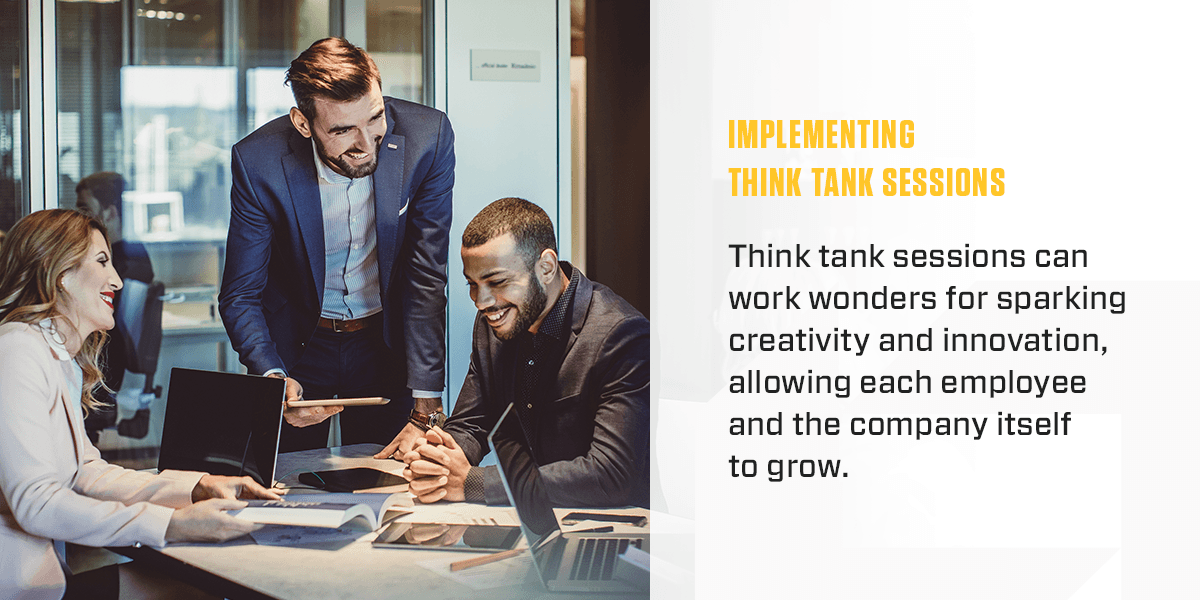What Is a Think Tank Session?

The term "think tank" can seem a bit ambiguous. A think tank can happen on many levels to achieve various goals, which are typically to create new policies, theories and resolutions to issues. However, you must keep a few points in mind to ensure your think tank is successful. Once you consider how your think tank should operate, you can take steps to achieve whatever you've decided on as your desired result.
Overall, think tanks offer many positives for organizations. Below, you'll find all you need to know about think tanks, including what they do, what types of think tanks exist and what attributes help them thrive. As a result, you can implement a think tank mentality in your daily work.
Table of Contents
- What Do Think Tanks Do?
- Types of Think Tanks
- Implementing Think Tank Sessions
- What Makes Think Tanks Successful
What Is A Think Tank & What Do They Do?
A think tank is a collaborative group dedicated to generating innovative ideas and solutions. These groups operate on various scales, aiming to address diverse challenges and formulate new policies and theories. Think tanks offer valuable insights, fostering creativity and innovation within organizations. Here's an overview of think tanks, their types, and how to conduct successful think tank sessions.
These teams can be as large as entire organizations, such as the Earth Institute, which Columbia University founded to address climate-related issues. However, think tanks can also operate on smaller scales within companies, where they adopt a think tank organization culture. Either way, think tanks aim to solve problems through brainstorming, research and other tactics.
Types of Think Tanks
There are a few kinds of think tanks. The distinction mainly depends on where and why the think tank was established. While all types aim to offer solutions for issues, each one has its own mission, aspirations and interests. Here are some examples of common think tanks:
- University-affiliated think tank: These think tanks operate inside of universities, mainly to research policies and theories. An example would be the Hoover Institution, which is associated with Stanford University.
- Government-affiliated think tank: A government-affiliated think tank is part of the government, whether at the local, state or federal level. For instance, the Center for Strategic and Budgetary Assessments is a think tank funded by the United States Department of Defense.
- Political party-affiliated think tank: Many think tanks align themselves with certain political parties, meaning their goals reflect that party's beliefs. Political party-affiliated think tanks are formally part of a political party, such as the New Democrat Network.
- Autonomous think tank: An independent think tank operates without funding from any interest groups. The Guttmacher Institute is one example, as it used to be a division of Planned Parenthood that has since become autonomous.
- For-profit think tank: Some think tanks are for-profit, meaning they're created within a company or are otherwise operated for profit.

Implementing Think Tank Sessions
Among the various types of think tanks, you can implement a think tank structure in your existing organization. Rather than forming a think tank like the examples listed above, you and your team can conduct think tank meetings to resolve problems and achieve goals. Through the think tank mindset, your department can establish effective company solutions for whatever kind of business you do.
The best part of using a think tank model is that you can customize it to your needs. Is your entire organization transitioning to a think tank structure? Do you plan on using think tank methods within your five-person department? Either way, think tank sessions can work wonders for sparking creativity and innovation, allowing each employee and the company itself to grow.
To begin operating like a think tank, consider the following:
1. Schedule Think Tank Meetings
First, you should set up a time for your think tank sessions. These could be 15-minute morning brainstorms or hour-long weekly meetings. A proper think tank session involves discussing an established topic and formulating solutions to reach that goal. Of course, how you organize your meetings is up to you — your team may work better typing up ideas on a computer, or they might want to write concepts down on a whiteboard.
Define the specifics of your think tank sessions so you can get them in motion.
2. Define Your Think Tank's Goals
Ultimately, a think tank isn't a think tank without aspirations. What do you plan to achieve with your meetings? For example, your IT department may be looking for ways to streamline tickets. If you set that as your initial think tank goal, your next step would be to work with your team to brainstorm ways to do that. Once you research and experiment with different solutions, you can implement the one that makes the most sense.
3. Get Help From a Think Tank Partner
If you feel stuck during your think tank meetings, partnering with a company that offers innovation labs and similar think tank sessions can help. This way, you don't have to do the heavy lifting for your team. Instead, everyone can attend the session ready to put their best ideas in the ring as they get their creative juices flowing. This strategy helps you achieve even better results since an expert will lead the think tank meetings.
What Makes a Think Tank Successful
The most important aspect of a think tank is a willingness to innovate. The world's most impactful think tanks have dozens of policy and research experts at their disposal, all of them prepared to work toward their shared goals. It's not always easy to achieve the same enthusiasm on a smaller scale. However, you can work toward creating fruitful think tank sessions so long as your team is open-minded.
When working through your think tank sessions, you'll want to ensure every participant is motivated to achieve the group's outlined goals. Additionally, think tanks require accountability, which stems from the willingness to innovate. If your team members aren't interested in keeping each other focused on thinking of new ideas, your sessions won't be very productive.
Overall, your meetings should prioritize collaboration, curiosity and creativity to reach the symbolic finish line as it pertains to your goals.
Think Tanks With Technology Partners
At Technology Partners, we recognize how effective it can be when the best minds work together. That's why we work with companies like yours to hold innovation labs, helping your employees get their creative juices flowing. As a result, your team can dive deeper into the changes it should make to be successful. With all kinds of IT solutions in addition to our innovation labs, Technology Partners is your trusted strategic ally.

Contact Us About Our Think Tanks
Do you want to learn more about how Technology Partners can help your organization spark innovation? Contact us today to get started with our innovation labs or speak with us about our wide array of other solutions.




